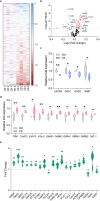Chronic Stress Alters Synaptic Inhibition/Excitation Balance of Pyramidal Neurons But Not PV Interneurons in the Infralimbic and Prelimbic Cortices of C57BL/6J Mice
- PMID: 39147579
- PMCID: PMC11351013
- DOI: 10.1523/ENEURO.0053-24.2024
Chronic Stress Alters Synaptic Inhibition/Excitation Balance of Pyramidal Neurons But Not PV Interneurons in the Infralimbic and Prelimbic Cortices of C57BL/6J Mice
Abstract
The medial prefrontal cortex (mPFC) plays a pivotal role in regulating working memory, executive function, and self-regulatory behaviors. Dysfunction in the mPFC circuits is a characteristic feature of several neuropsychiatric disorders including schizophrenia, depression, and post-traumatic stress disorder. Chronic stress (CS) is widely recognized as a major triggering factor for the onset of these disorders. Although evidence suggests synaptic dysfunction in mPFC circuits following CS exposure, it remains unclear how different neuronal populations in the infralimbic (IL) and prelimbic (PL) cortices are affected in terms of synaptic inhibition/excitation balance (I/E ratio). Here, using neuroproteomic analysis and whole-cell patch-clamp recordings in pyramidal neurons (PNs) and parvalbumin (PV) interneurons within the PL and IL cortices, we examined the synaptic changes after 21 d of chronic unpredictable stress, in male mice. Our results reveal distinct impacts of CS on PL and IL PNs, resulting in an increased I/E ratio in both subregions but through different mechanisms: CS increases inhibitory synaptic drive in the PL while decreasing excitatory synaptic drive in the IL. Notably, the I/E ratio and excitatory and inhibitory synaptic drive of PV interneurons remained unaffected in both PL and IL circuits following CS exposure. These findings offer novel mechanistic insights into the influence of CS on mPFC circuits and support the hypothesis of stress-induced mPFC hypofunction.
Keywords: I/E ratio; chronic stress; electrophysiology; mPFC; neuroproteomics.
Copyright © 2024 Rodrigues et al.
Conflict of interest statement
The authors declare no competing financial interests.
Figures






Similar articles
-
δ-Containing GABAA receptors on parvalbumin interneurons modulate neuronal excitability and network dynamics in the mouse medial prefrontal cortex.J Neurophysiol. 2025 Apr 1;133(4):1003-1013. doi: 10.1152/jn.00495.2024. Epub 2025 Feb 27. J Neurophysiol. 2025. PMID: 40013665 Free PMC article.
-
Interneuron Transcriptional Dysregulation Causes Frequency-Dependent Alterations in the Balance of Inhibition and Excitation in Hippocampus.J Neurosci. 2015 Nov 18;35(46):15276-90. doi: 10.1523/JNEUROSCI.1834-15.2015. J Neurosci. 2015. PMID: 26586816 Free PMC article.
-
Ketamine Administration During the Second Postnatal Week Alters Synaptic Properties of Fast-Spiking Interneurons in the Medial Prefrontal Cortex of Adult Mice.Cereb Cortex. 2016 Mar;26(3):1117-29. doi: 10.1093/cercor/bhu293. Epub 2014 Dec 4. Cereb Cortex. 2016. PMID: 25477370
-
The excitatory-inhibitory balance as a target for the development of novel drugs to treat schizophrenia.Biochem Pharmacol. 2024 Oct;228:116298. doi: 10.1016/j.bcp.2024.116298. Epub 2024 May 21. Biochem Pharmacol. 2024. PMID: 38782077 Review.
-
Prefrontal Interneurons: Populations, Pathways, and Plasticity Supporting Typical and Disordered Cognition in Rodent Models.J Neurosci. 2022 Nov 9;42(45):8468-8476. doi: 10.1523/JNEUROSCI.1136-22.2022. J Neurosci. 2022. PMID: 36351822 Free PMC article. Review.
Cited by
-
Chronic unpredictable stress produces hyperalgesia and promotes inhibitory drive in medial prefrontal cortex.J Pain. 2025 Aug;33:105452. doi: 10.1016/j.jpain.2025.105452. Epub 2025 May 29. J Pain. 2025. PMID: 40449675
-
From Stress to Synapse: The Neuronal Atrophy Pathway to Mood Dysregulation.Int J Mol Sci. 2025 Mar 30;26(7):3219. doi: 10.3390/ijms26073219. Int J Mol Sci. 2025. PMID: 40244068 Free PMC article. Review.
-
Opposing roles of microglial and macrophagic C3ar1 signaling in stress-induced synaptic and behavioral changes.Mol Psychiatry. 2025 Jul 10. doi: 10.1038/s41380-025-03097-8. Online ahead of print. Mol Psychiatry. 2025. PMID: 40640554
References
-
- Amaya KA, Smith KS (2018) Neurobiology of habit formation. Curr Opin Behav Sci 20:145–152. 10.1016/j.cobeha.2018.01.003 - DOI
MeSH terms
Substances
LinkOut - more resources
Full Text Sources
Medical
Molecular Biology Databases
